Qingwei Lin
AdaptFlow: Adaptive Workflow Optimization via Meta-Learning
Aug 11, 2025Abstract:Recent advances in large language models (LLMs) have sparked growing interest in agentic workflows, which are structured sequences of LLM invocations intended to solve complex tasks. However, existing approaches often rely on static templates or manually designed workflows, which limit adaptability to diverse tasks and hinder scalability. We propose AdaptFlow, a natural language-based meta-learning framework inspired by model-agnostic meta-learning (MAML). AdaptFlow learns a generalizable workflow initialization that enables rapid subtask-level adaptation. It employs a bi-level optimization scheme: the inner loop refines the workflow for a specific subtask using LLM-generated feedback, while the outer loop updates the shared initialization to perform well across tasks. This setup allows AdaptFlow to generalize effectively to unseen tasks by adapting the initialized workflow through language-guided modifications. Evaluated across question answering, code generation, and mathematical reasoning benchmarks, AdaptFlow consistently outperforms both manually crafted and automatically searched baselines, achieving state-of-the-art results with strong generalization across tasks and models. The source code and data are available at https://github.com/microsoft/DKI_LLM/tree/AdaptFlow/AdaptFlow.
SWE-bench Goes Live!
May 29, 2025Abstract:The issue-resolving task, where a model generates patches to fix real-world bugs, has emerged as a critical benchmark for evaluating the capabilities of large language models (LLMs). While SWE-bench and its variants have become standard in this domain, they suffer from key limitations: they have not been updated since their initial releases, cover a narrow set of repositories, and depend heavily on manual effort for instance construction and environment setup. These factors hinder scalability and introduce risks of overfitting and data contamination. In this work, we present \textbf{SWE-bench-Live}, a \textit{live-updatable} benchmark designed to overcome these challenges. Our initial release consists of 1,319 tasks derived from real GitHub issues created since 2024, spanning 93 repositories. Each task is accompanied by a dedicated Docker image to ensure reproducible execution. Central to our benchmark is \method, an automated curation pipeline that streamlines the entire process from instance creation to environment setup, removing manual bottlenecks and enabling scalability and continuous updates. We evaluate a range of state-of-the-art agent frameworks and LLMs on SWE-bench-Live, revealing a substantial performance gap compared to static benchmarks like SWE-bench, even under controlled evaluation conditions. To better understand this discrepancy, we perform detailed analyses across repository origin, issue recency, and task difficulty. By providing a fresh, diverse, and executable benchmark grounded in live repository activity, SWE-bench-Live facilitates rigorous, contamination-resistant evaluation of LLMs and agents in dynamic, real-world software development settings.
Text2Grad: Reinforcement Learning from Natural Language Feedback
May 28, 2025Abstract:Traditional RLHF optimizes language models with coarse, scalar rewards that mask the fine-grained reasons behind success or failure, leading to slow and opaque learning. Recent work augments RL with textual critiques through prompting or reflection, improving interpretability but leaving model parameters untouched. We introduce Text2Grad, a reinforcement-learning paradigm that turns free-form textual feedback into span-level gradients. Given human (or programmatic) critiques, Text2Grad aligns each feedback phrase with the relevant token spans, converts these alignments into differentiable reward signals, and performs gradient updates that directly refine the offending portions of the model's policy. This yields precise, feedback-conditioned adjustments instead of global nudges. Text2Grad is realized through three components: (1) a high-quality feedback-annotation pipeline that pairs critiques with token spans; (2) a fine-grained reward model that predicts span-level reward on answer while generating explanatory critiques; and (3) a span-level policy optimizer that back-propagates natural-language gradients. Across summarization, code generation, and question answering, Text2Grad consistently surpasses scalar-reward RL and prompt-only baselines, providing both higher task metrics and richer interpretability. Our results demonstrate that natural-language feedback, when converted to gradients, is a powerful signal for fine-grained policy optimization. The code for our method is available at https://github.com/microsoft/Text2Grad
RePrompt: Reasoning-Augmented Reprompting for Text-to-Image Generation via Reinforcement Learning
May 23, 2025Abstract:Despite recent progress in text-to-image (T2I) generation, existing models often struggle to faithfully capture user intentions from short and under-specified prompts. While prior work has attempted to enhance prompts using large language models (LLMs), these methods frequently generate stylistic or unrealistic content due to insufficient grounding in visual semantics and real-world composition. Inspired by recent advances in reasoning for language model, we propose RePrompt, a novel reprompting framework that introduces explicit reasoning into the prompt enhancement process via reinforcement learning. Instead of relying on handcrafted rules or stylistic rewrites, our method trains a language model to generate structured, self-reflective prompts by optimizing for image-level outcomes. The tailored reward models assesse the generated images in terms of human preference, semantic alignment, and visual composition, providing indirect supervision to refine prompt generation. Our approach enables end-to-end training without human-annotated data. Experiments on GenEval and T2I-Compbench show that RePrompt significantly boosts spatial layout fidelity and compositional generalization across diverse T2I backbones, establishing new state-of-the-art results.
Zoomer: Adaptive Image Focus Optimization for Black-box MLLM
Apr 30, 2025



Abstract:Recent advancements in multimodal large language models (MLLMs) have broadened the scope of vision-language tasks, excelling in applications like image captioning and interactive question-answering. However, these models struggle with accurately processing visual data, particularly in tasks requiring precise object recognition and fine visual details. Stringent token limits often result in the omission of critical information, hampering performance. To address these limitations, we introduce \SysName, a novel visual prompting mechanism designed to enhance MLLM performance while preserving essential visual details within token limits. \SysName features three key innovations: a prompt-aware strategy that dynamically highlights relevant image regions, a spatial-preserving orchestration schema that maintains object integrity, and a budget-aware prompting method that balances global context with crucial visual details. Comprehensive evaluations across multiple datasets demonstrate that \SysName consistently outperforms baseline methods, achieving up to a $26.9\%$ improvement in accuracy while significantly reducing token consumption.
UFO2: The Desktop AgentOS
Apr 20, 2025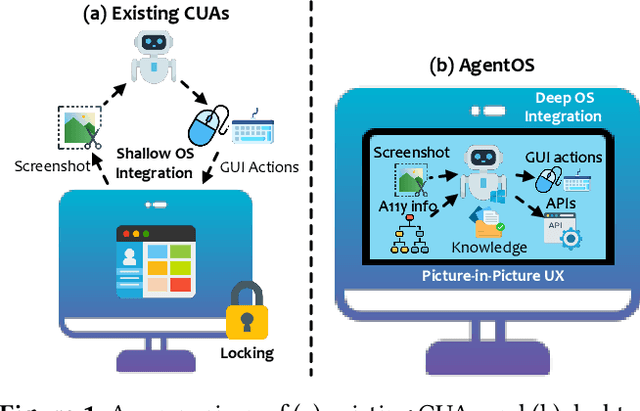
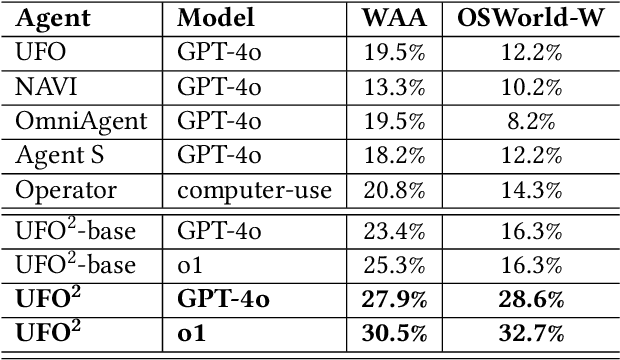
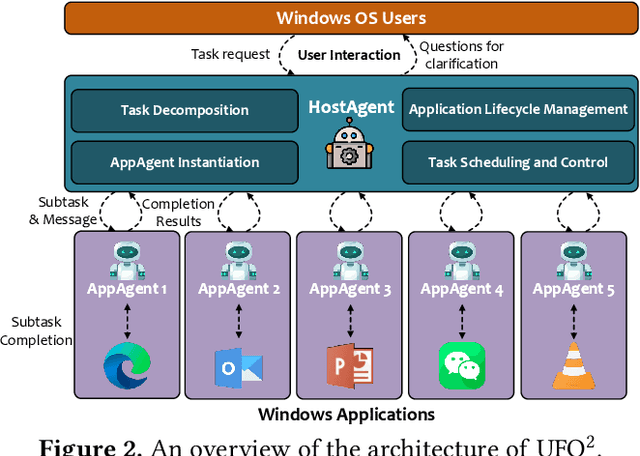

Abstract:Recent Computer-Using Agents (CUAs), powered by multimodal large language models (LLMs), offer a promising direction for automating complex desktop workflows through natural language. However, most existing CUAs remain conceptual prototypes, hindered by shallow OS integration, fragile screenshot-based interaction, and disruptive execution. We present UFO2, a multiagent AgentOS for Windows desktops that elevates CUAs into practical, system-level automation. UFO2 features a centralized HostAgent for task decomposition and coordination, alongside a collection of application-specialized AppAgent equipped with native APIs, domain-specific knowledge, and a unified GUI--API action layer. This architecture enables robust task execution while preserving modularity and extensibility. A hybrid control detection pipeline fuses Windows UI Automation (UIA) with vision-based parsing to support diverse interface styles. Runtime efficiency is further enhanced through speculative multi-action planning, reducing per-step LLM overhead. Finally, a Picture-in-Picture (PiP) interface enables automation within an isolated virtual desktop, allowing agents and users to operate concurrently without interference. We evaluate UFO2 across over 20 real-world Windows applications, demonstrating substantial improvements in robustness and execution accuracy over prior CUAs. Our results show that deep OS integration unlocks a scalable path toward reliable, user-aligned desktop automation.
API Agents vs. GUI Agents: Divergence and Convergence
Mar 14, 2025Abstract:Large language models (LLMs) have evolved beyond simple text generation to power software agents that directly translate natural language commands into tangible actions. While API-based LLM agents initially rose to prominence for their robust automation capabilities and seamless integration with programmatic endpoints, recent progress in multimodal LLM research has enabled GUI-based LLM agents that interact with graphical user interfaces in a human-like manner. Although these two paradigms share the goal of enabling LLM-driven task automation, they diverge significantly in architectural complexity, development workflows, and user interaction models. This paper presents the first comprehensive comparative study of API-based and GUI-based LLM agents, systematically analyzing their divergence and potential convergence. We examine key dimensions and highlight scenarios in which hybrid approaches can harness their complementary strengths. By proposing clear decision criteria and illustrating practical use cases, we aim to guide practitioners and researchers in selecting, combining, or transitioning between these paradigms. Ultimately, we indicate that continuing innovations in LLM-based automation are poised to blur the lines between API- and GUI-driven agents, paving the way for more flexible, adaptive solutions in a wide range of real-world applications.
VEM: Environment-Free Exploration for Training GUI Agent with Value Environment Model
Feb 26, 2025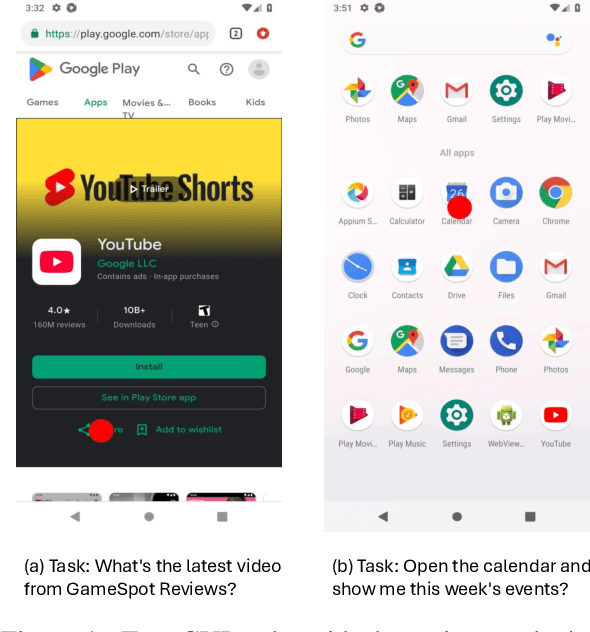

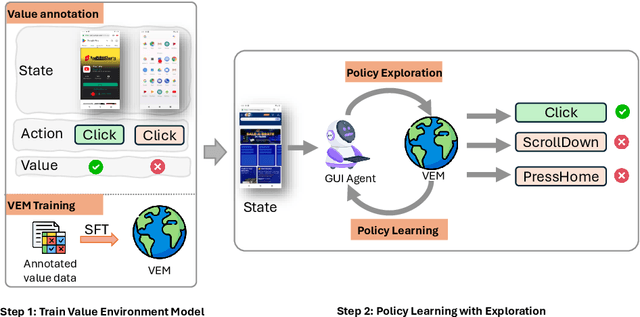

Abstract:Training Vision-Language Models (VLMs) for Graphical User Interfaces (GUI) agents via Reinforcement Learning (RL) faces critical challenges: environment-based RL requires costly interactions, while environment-free methods struggle with distribution shift and reward generalization. We propose an environment-free RL framework that decouples value estimation from policy optimization by leveraging a pretrained Value Environment Model (VEM). VEM predicts state-action values directly from offline data, distilling human-like priors about GUI interaction outcomes without requiring next-state prediction or environmental feedback. This avoids compounding errors and enhances resilience to UI changes by focusing on semantic reasoning (e.g., Does this action advance the user's goal?). The framework operates in two stages: (1) pretraining VEM to estimate long-term action utilities and (2) guiding policy exploration with frozen VEM signals, enabling layout-agnostic GUI automation. Evaluated on Android-in-the-Wild benchmarks, VEM achieves state-of-the-art performance in both offline and online settings, outperforming environment-free baselines significantly and matching environment-based approaches without interaction costs. Importantly, VEM demonstrates that semantic-aware value estimation can achieve comparable performance with online-trained methods.
Distill Not Only Data but Also Rewards: Can Smaller Language Models Surpass Larger Ones?
Feb 26, 2025Abstract:Distilling large language models (LLMs) typically involves transferring the teacher model's responses through supervised fine-tuning (SFT). However, this approach neglects the potential to distill both data (output content) and reward signals (quality evaluations). Extracting reliable reward signals directly from teacher models is challenging, as LLMs are optimized for generation rather than evaluation, often resulting in biased or inconsistent assessments. To address this limitation, we propose a novel distillation pipeline that transfers both responses and rewards. Our method generates pseudo-rewards through a self-supervised mechanism that leverages the inherent structure of both teacher and student responses, enabling reward learning without explicit external evaluation. The reward model subsequently guides reinforcement learning (RL), allowing iterative refinement of the student model after an SFT warm-up phase. Experiments on GSM8K and MMLU-PRO demonstrate that our method consistently outperforms traditional SFT-based approaches, enabling student models to surpass the performance of their teachers. This work highlights the potential for scalable, efficient distillation through structured self-supervised reward learning, reducing dependence on external reward supervision.
Lean and Mean: Decoupled Value Policy Optimization with Global Value Guidance
Feb 24, 2025Abstract:Proximal Policy Optimization (PPO)-based Reinforcement Learning from Human Feedback (RLHF) is essential for aligning large language models (LLMs) with human preferences. It requires joint training of an actor and critic with a pretrained, fixed reward model for guidance. This approach increases computational complexity and instability due to actor-critic interdependence. Additionally, PPO lacks access to true environment rewards in LLM tasks, limiting its adaptability. Under such conditions, pretraining a value model or a reward model becomes equivalent, as both provide fixed supervisory signals without new ground-truth feedback. To address these issues, we propose \textbf{Decoupled Value Policy Optimization (DVPO)}, a lean framework that replaces traditional reward modeling with a pretrained \emph{global value model (GVM)}. The GVM is conditioned on policy trajectories and predicts token-level return-to-go estimates. By decoupling value model from policy training (via frozen GVM-driven RL objectives), DVPO eliminates actor-critic interdependence, reducing GPU memory usage by 40\% and training time by 35\% compared to conventional RLHF. Experiments across benchmarks show DVPO outperforms efficient RLHF methods (e.g., DPO) while matching state-of-the-art PPO in performance.
 Add to Chrome
Add to Chrome Add to Firefox
Add to Firefox Add to Edge
Add to Edge